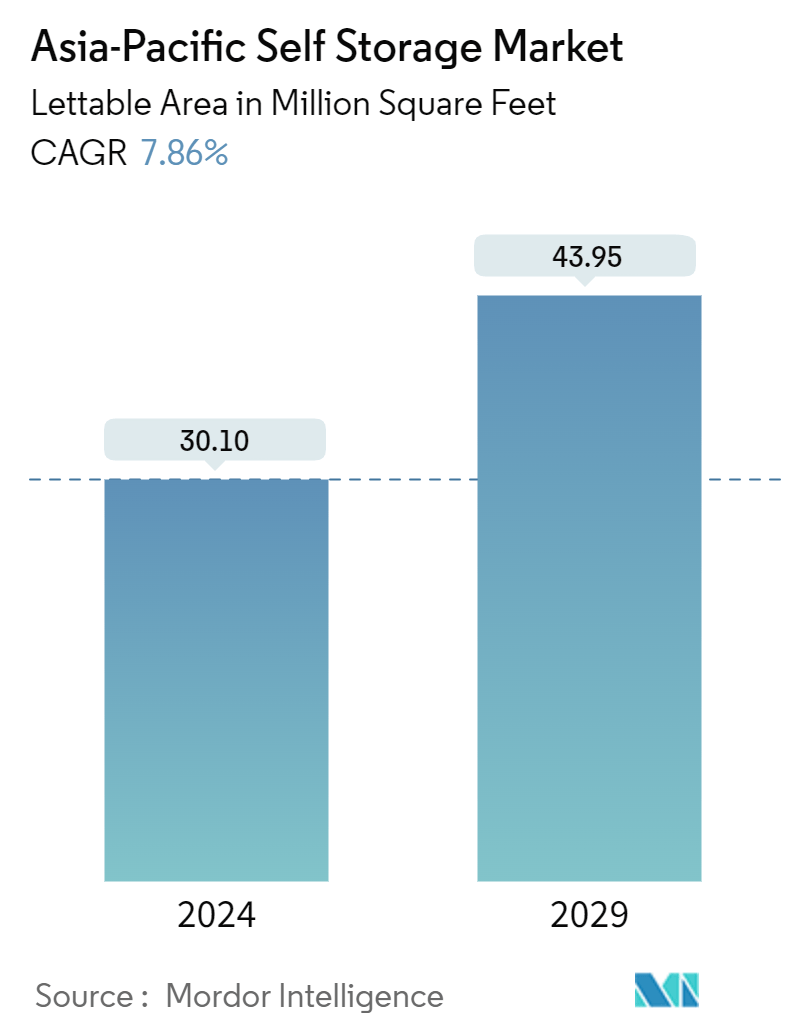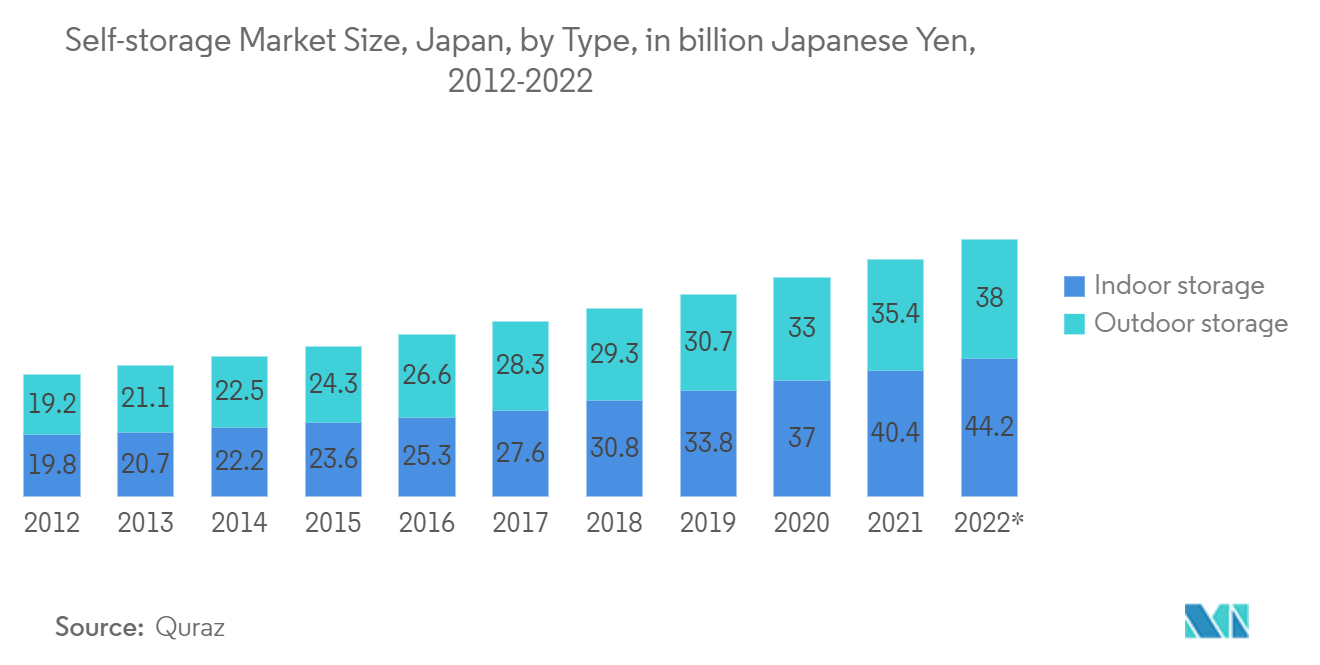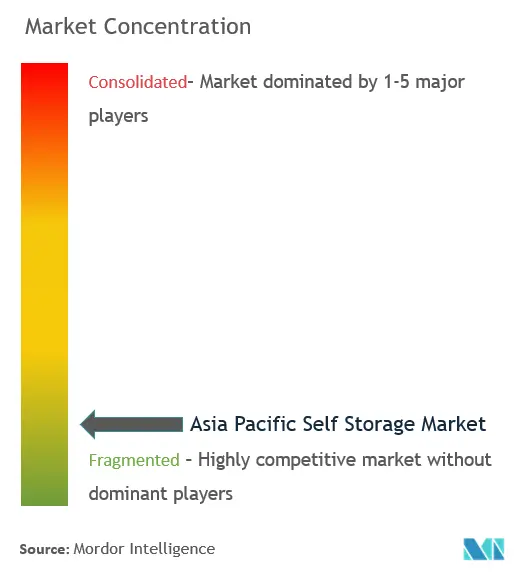APAC Self Storage Market Size

| Study Period | 2019 - 2029 |
| Base Year For Estimation | 2023 |
| Forecast Data Period | 2024 - 2029 |
| Historical Data Period | 2019 - 2022 |
| CAGR (2024 - 2029) | 7.86 % |
| Market Concentration | Low |
Major Players
*Disclaimer: Major Players sorted in no particular order |
APAC Self Storage Market Analysis
The Asia-Pacific Self Storage Market size in terms of lettable area is expected to grow from 30.10 Million square feet in 2024 to 43.95 Million square feet by 2029, at a CAGR of 7.86% during the forecast period (2024-2029).
The market is transitioning considerably since the business grows at different rates in different countries. This is based on parameters such as ownership/property type, land rate, and investment models.
- The growing population in Asia-Pacific, as indicated in the graph alongside the urbanization, public awareness, and the expansion of small enterprises, especially in countries like Hong Kong, Taiwan, Malaysia, and so on, are analyzed to boost the demand for self-storage facilities in the region.
- Additional factors driving the demand for self-storage facilities include e-commerce expansion, increased remote working and flexible office space, ongoing migration into cities, and the rapid development of renters.
- The growing living space costs in the region significantly contribute to the market growth rate. For instance, the living space per person in Hong Kong is much less compared to developed economies like the United States. To provide more context, according to the Census and Statistics Department of Hong Kong, in 2021, the average living space of public rental housing tenants in Hong Kong was 13.5 sq. m per person, and it has historically remained between 13 to 13.5 sq. m from 2017 to 2021.
- Urbanizable/developable land is both expensive and scarce. Building bye-laws and planning regulations are two ways that local governments control and manage development. Many cities have development control laws created years ago and have been modified haphazardly without enough empirical proof of their effects.
- COVID-19 has impacted several economies and industries; however, some industries continue to expand steadily. The self-storage industry has not been severely affected by the pandemic and has grown gradually with the consumer demand for storage. The past two years of the pandemic have seen enormous individual relocations and office space reductions. Due to this circumstance, the demand for self-storage has increased at an unprecedented rate.
APAC Self Storage Market Trends
Rising Consumerism and Population Density is Driving the Market Growth
- Self-storage facilities are expanding steadily in the region, despite many businesses struggling during difficult economic times. Demand for self-storage is surging as a culture of consumerism, the expansion of e-commerce, the constricting availability of living space, and the growing population drive demand from individuals and families for safe and efficient facilities for storing personal items.
- Growing urbanization is one of the significant factors positively driving market growth. Growing urban populations result in more tenants who move around frequently and smaller, more expensive living areas in cities. Self-storage businesses have established themselves in Asia's more populous and affluent regional cities. Affluent neighborhoods tend to have a greater propensity for inhabitants to buy luxuries that take up more room in their homes. There is an increasing demand for specialized storage options, such as climate-controlled storage containers, to preserve expensive goods such as wine, antique furniture, or electronics.
- In the region, the smallest average dwelling sizes are found in Singapore, Hong Kong, and Tokyo. Singapore has a dense population and the smallest dwelling sizes in Asia, with an average of 730 square feet. More than 75% of residential units lack a storage area. According to information from the Urban Redevelopment Authority (URA), housing prices have increased in Singapore over the last five years. Furthermore, the growing population density in countries such as China and India contributes to the market growth rate during the forecast period. Self-storage companies have expanded all over Asia, remodeling aging facilities and preparing brand-new construction. Additionally, to meet the market's shifting demands, the nation is expected to experience an increase in demand for long-term storage users, resulting in notable expansions in the region.

Japan to have the Largest Lettable Area in the Asia Pacific Region
- In Japan, the self-storage market has gradually gained recognition among consumers and as a new real estate investment product, leading to market expansion in the past few years. Decentralizing the housing of furniture and valuables, stockpiling survival food for emergency and natural disasters such as earthquakes, and attention to the industry have intensified with self-storage.
- There are three self-storage business classifications in Japan: trunk room, rental-storage space, and rental container. First is the so-called "trunk room" managed under the Warehousing Business Act. These operators must repay customers for the stored property. Next, is a class called a "rental-storage space" that uses rooms set up in a building or specialized facility for leasing. The last class is called a "rental container," mainly set up outdoors for rental.
- Furthermore, the warehousing industry, which focused only on a business-to-business format, has expanded its business to the trunk-room business to target the general consumer as a new business type. Additionally, trunk room self-storage facilities are gaining significant traction, with the leading market vendors in the country offering innovative solutions. Self-storage facilities are called "trunk rooms" in Japan.
- For instance, according to the latest estimates based on the Annual Supply Survey conducted in November 2021 by Quraz, the storage room market (including indoor and outdoor) has expanded significantly to JPY 67 billion, doubling over the past ten years. Furthermore, according to the survey, new storage needs have arisen due to changes in the living environment, such as the rapid penetration of telework and online learning and the ongoing stay-at-home lifestyle.

APAC Self Storage Industry Overview
The Asian-Pacific self-storage market is highly fragmented due to the presence of many vendors in countries such as Japan, Singapore, Singapore, and Malaysia. Emerging countries like India account for a niche market, witnessing new entrants. Different players continue to expand their presence in new regions through new facilities.
- May 2022 - In Hong Kong, the fourth self-storage facility operated by StorHub began its operations. The storage facility could offer trustworthy and safe storage options to locals living in the area at Precious Industrial Centre, No. 18 Cheung Yu Street, in Cheung Sha Wan.
- March 2022 - QurazCo. Ltd announced a new service, "QurazHome Delivery Support," at all stores that could allow consumers to put in and take out luggage with their smartphone while staying home. "QurazHome Delivery Support" is a new service that responds to many customers' requests and enhances trunk rooms' convenience. With this service, it could be possible to take large items such as cardboard boxes, golf bags, and suitcases from the trunk room that consumers use while at home.
APAC Self Storage Market Leaders
-
Mandarin Self-storage Pte Ltd
-
Store Friendly Self-storage Group Ltd (GSC)
-
Boxful Limited
-
Quraz Ltd
-
Okinawa Self-storage
*Disclaimer: Major Players sorted in no particular order

APAC Self Storage Market News
- September 2022- The Indian Packer and Movers brand, Agarwal Packers and Movers Ltd, launched its self-storage company Storekar.com. The self-storage facility holds a top spot in the market for domestic and commercial customers. The company could offer customized and reliable self-storage solutions for individuals and businesses. It could have flexible plans to support both individual and bulk storage requirements.
- August 2022 - In Hung Hom, the fifth storage facility of StorHub Hong Kong was formally inaugurated. It is situated in the Eldex Industrial Building on 21 Ma Tau Wai Road in Hung Hom and offers local residents, families, and businesses trustworthy and safe storage options.
APAC Self Storage Market Report - Table of Contents
1. INTRODUCTION
- 1.1 Study Assumptions and Market Definition
- 1.2 Scope of the Study
2. RESEARCH METHODOLOGY
3. EXECUTIVE SUMMARY
4. MARKET INSIGHTS
- 4.1 Market Overview
-
4.2 Industry Attractiveness - Porters Five Forces Analysis
- 4.2.1 Bargaining Power of Suppliers
- 4.2.2 Bargaining Power of Buyers
- 4.2.3 Threat of New Entrants
- 4.2.4 Threat of Substitute Products
- 4.2.5 Intensity of Competitive Rivalry
- 4.3 Assessment of Impact of COVID-19 on the Market
5. MARKET DYNAMICS
-
5.1 Market Drivers
- 5.1.1 Rising Consumerism and Population Density
-
5.2 Market Restraints
- 5.2.1 Lack of Available Space to Build the Facilities
6. MARKET SEGMENTATION
-
6.1 By End User
- 6.1.1 Personal
- 6.1.2 Business
-
6.2 By Country***
- 6.2.1 Japan
- 6.2.2 China
- 6.2.3 Hong Kong
- 6.2.4 Taiwan
- 6.2.5 Singapore
- 6.2.6 Malaysia
7. COMPETITIVE LANDSCAPE
-
7.1 Company Profiles*
- 7.1.1 Mandarin Self-storage Pte Ltd
- 7.1.2 Store Friendly Self-storage Group Ltd (GSC)
- 7.1.3 Boxful Limited
- 7.1.4 Quraz Ltd
- 7.1.5 Okinawa Self-storage
- 7.1.6 StorHub Self-storage
- 7.1.7 UD Self-storage
- 7.1.8 Extra Space Asia
- 7.1.9 Far East Organization (Store Y Self Storage)
- 7.1.10 Storage King Group
8. INVESTMENT ANALYSIS
9. FUTURE OF THE MARKET
** Subject To AvailablityAPAC Self Storage Industry Segmentation
A self-storage facility provides a rented space for storing one's belonging and goods. This can be for personal or commercial services availed by the client, depending upon the purpose of renting the storage facility. Companies also provide advanced security options and climate-controlled spaces, depending on the client's needs.
The study tracks the key market parameters, underlying growth influencers, and major vendors operating in the industry, which supports the market estimations and growth rates during the forecast period. The study tracks the total lettable area across countries in Asia-Pacific. The study provides the Asian-Pacific market trends, along with key vendor profiles. The study analyzes the impact of COVID-19 on the ecosystem.
The Asia Pacific self storage market is segmented by end-user (personal and business) and country (Japan, China, Hong Kong and Taiwan, Singapore, Malaysia and the rest of Asia Pacific). The report offers market sizes and forecasts in terms of total lettable area (square feet) for all the above segments.
| By End User | Personal |
| Business | |
| By Country*** | Japan |
| China | |
| Hong Kong | |
| Taiwan | |
| Singapore | |
| Malaysia |
APAC Self Storage Market Research FAQs
How big is the Asia-Pacific Self Storage Market?
The Asia-Pacific Self Storage Market size is expected to reach 30.10 million square feet in 2024 and grow at a CAGR of 7.86% to reach 43.95 million square feet by 2029.
What is the current Asia-Pacific Self Storage Market size?
In 2024, the Asia-Pacific Self Storage Market size is expected to reach 30.10 million square feet.
Who are the key players in Asia-Pacific Self Storage Market?
Mandarin Self-storage Pte Ltd, Store Friendly Self-storage Group Ltd (GSC), Boxful Limited, Quraz Ltd and Okinawa Self-storage are the major companies operating in the Asia-Pacific Self Storage Market.
What years does this Asia-Pacific Self Storage Market cover, and what was the market size in 2023?
In 2023, the Asia-Pacific Self Storage Market size was estimated at 27.73 million square feet. The report covers the Asia-Pacific Self Storage Market historical market size for years: 2019, 2020, 2021, 2022 and 2023. The report also forecasts the Asia-Pacific Self Storage Market size for years: 2024, 2025, 2026, 2027, 2028 and 2029.
APAC Self Storage Industry Report
Statistics for the 2023 APAC Self Storage market share, size and revenue growth rate, created by Mordor Intelligence™ Industry Reports. APAC Self Storage analysis includes a market forecast outlook to 2029 and historical overview. Get a sample of this industry analysis as a free report PDF download.



